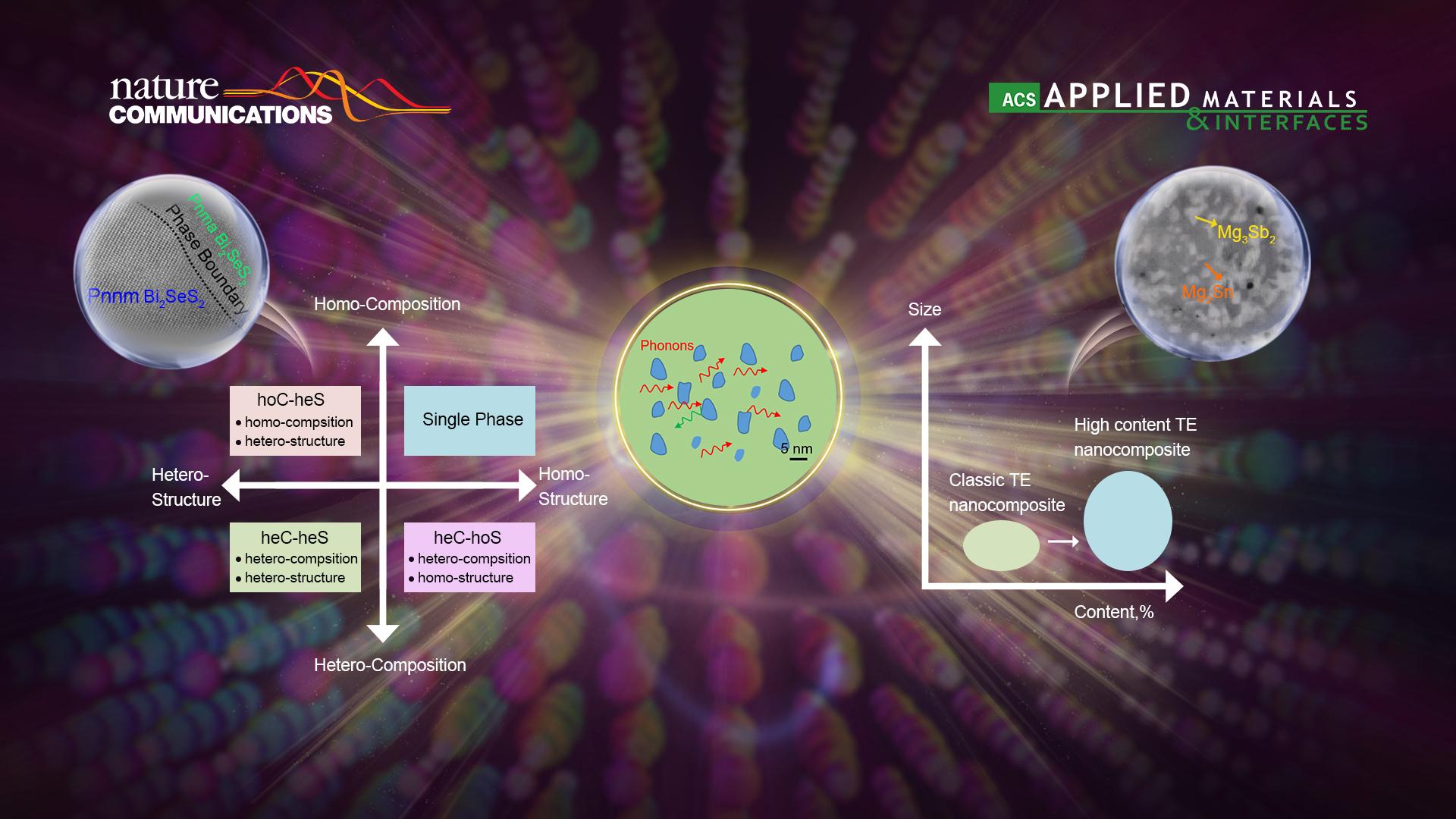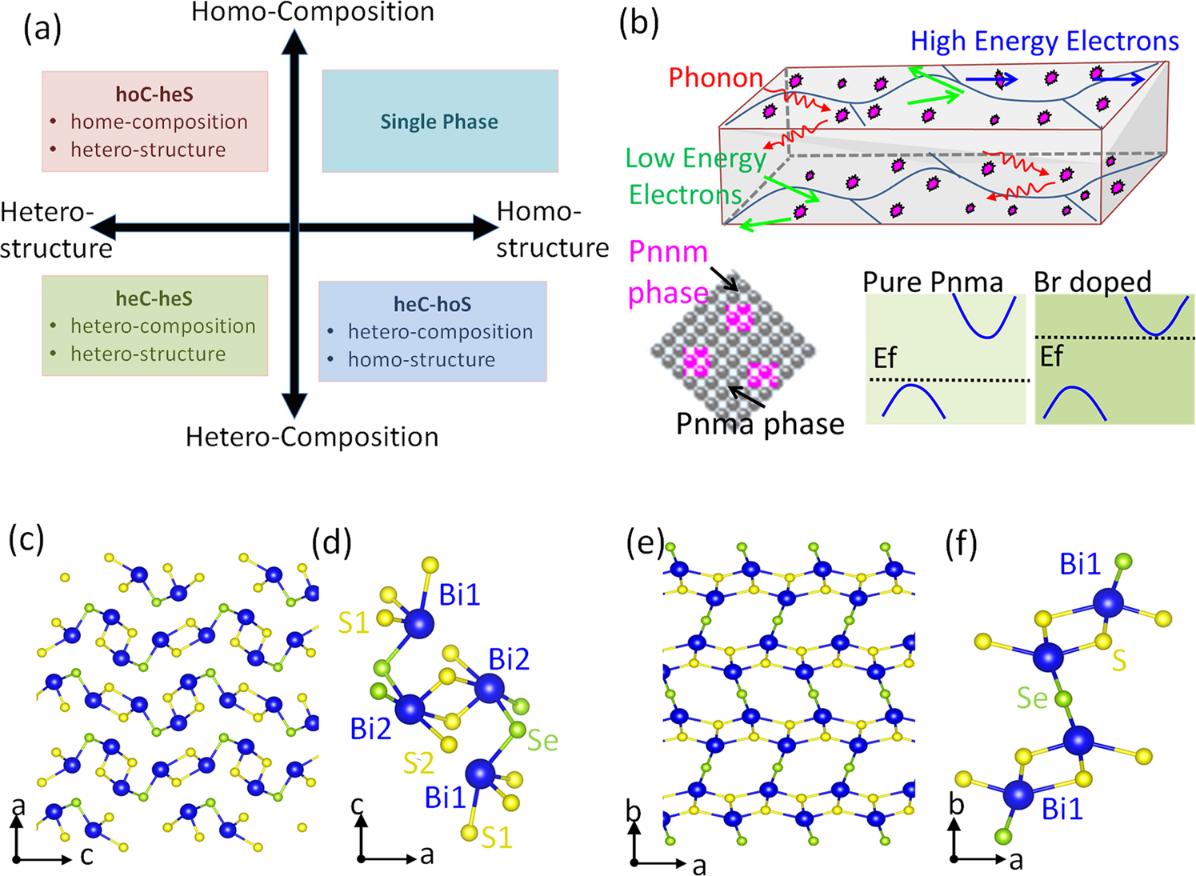Thermoelectric nanocomposite is one of the hot topics in the field of thermoelectric materials, including both the externally added nanoparticles or internally precipitates from the matrix. Associate Professor Weishu Liu’s team from the Department of Materials Science and Engineering at the Southern University of Science and Technology (SUSTech) and their co-authors have made significant progress in exploring new thermoelectric nanocomposites.

The first study is about the high-content nanocomposite Mg2Sn/Mg3Sb2. Their research, entitled “Enhanced Thermoelectric Performance by Strong Phonon Scattering at the Heterogeneous Interfaces of the Mg2Sn/Mg3Sb2High-Content Nanocomposite,” was published in ACS Applied Materials & Interfaces.
Mg2Sn is a potential thermoelectric (TE) material that can directly convert waste heat into electricity. The classic TE nanocomposite usually has a very low-content second phase. The enhanced TE performance is mainly raised from the Rayleigh scattering of nano inclusion to the phonons. However, in the proposed high-content nanocomposite Mg2Sn/Mg3Sb2, the heterogeneous interface is the dominant mechanism for the phonon scattering, as shown in Figure 1. The heterogeneous interface resistance (or Kapitza resistance Rk) was estimated, i.e., Rk = 7×10-7 m2 K W-1 (30-150 °C) and 8.2×10-7 m2 K W-1 (150-500 °C), which is one order of magnitude higher than polycrystalline grain boundary. As a result, the high-content nanocomposite Mg2Sn/Mg3Sb2 shows an extremely low value of 1.09 W m-1 K-1 at room temperature, which is only 21% of the pure Mg2Sn.

Figure 1. Mg2Sn/Mg3Sb2 heterogeneous interfaces with high Kapitza resistance effectively decreasing lattice thermal conductivity of Mg2Sn matrix
Yongbing Zhu, a Ph.D. student at SUSTech, is the first author of this paper. Associated Professor Weishu Liu from SUSTech is the corresponding author.
This work was supported by the State’s Key Project of Research and Development Plan, the National Natural Science Foundation of China (NSFC), the Guangdong Innovative and Entrepreneurial Research Team Program, and the Shenzhen Basic Research Fund. The authors also acknowledge the support of the Tencent Foundation through the Xplorer Prize.
The second study, entitled “Homo-composition and Hetero-structure Nanocomposite Pnma Bi2SeS2 – Pnnm Bi2SeS2 with High Thermoelectric Performance,” was published in Nature Communications. It focused on homo-composition and heterostructure nanocomposite Pnma Bi2SeS2 – Pnnm Bi2SeS2. The composition and structure differences between the second phase and the matrix are two critical dimensions for classing the nanocomposite (Figure 2a). Most classic thermoelectric nanocomposites could be classified into quadrant 3# (heterocomposition and heterostructure) and quadrant 4# (heterocomposition and homostructure).
In this work, the researchers fill the gap of quadrant 2# (homo-composition and hetero-structure). They proposed Bromine (Br) dopant-induced phase transition to realize hoC-hoS nanocomposites, different from previous reports on heterocomposition and heterostructure (heC-heS) or heterocomposition and homostructure (heC-hoS) nanocomposites. Given slight structure difference between Pnma Bi2SeS2 and Pnnm Bi2SeS2, coherent interfaces and local structure disorder were formed by Br dopant-induced phase transition, which benefits to reduce lattice thermal conductivity, not carrier mobility. As a result, a high PF of more than 7.30 μW cm−1 K−2 at 773 K was obtained, inducing a record high ZTmax of 1.12 and a record high ZTave of 0.72 (at 323–773 K) in the optimal Br-doped Pnma Bi2SeS2 – Pnnm Bi2SeS2 nanocomposite (nominal composition: Bi2Se0.88Br0.12S2).

Figure 2. Schematic representation of the nanocomposite and crystal structure of Bi2SeS2. (a) Summary of previously reported nanocomposites classified by the composition and crystal structure of their nanoinclusion and matrix. (b) Structure and schematic illustration of transport mechanism inside Pnma Bi2SeS2 – Pnnm Bi2SeS2 hoC–heS nanocomposite. (c–d) Crystal structure of Bi2SeS2 Pnma phase in the ac plane. (e–f) Crystal structure of Bi2SeS2 Pnnm phase in the ab plane.
The idea of hoC-hoS nanocomposite thermoelectric materials was used to realize synergistic regulation of electrical and thermal transport to improve thermoelectric properties through a dopant-induced phase transition, providing a new strategy for designing high-performance nanocomposite thermoelectric materials.
Bushra Jabar, a Ph.D. student from Shenzhen University (SZU), is the first author of this paper. Associate Research Fu Li and Professor Ping Fan, both of SZU, and Associate Professor Weishu Liu from SUSTech are the co-corresponding authors.
This study was supported by the State’s Key Project of Research and Development Plan, NSFC, the Natural Science Foundation of Guangdong Province of China, the Guangdong Innovative and Entrepreneurial Research Team Program, Natural Science Foundation of SZU, and the Shenzhen Key Projects of Long Term Academic Support Plan.
Paper links:
https://pubs.acs.org/doi/abs/10.1021/acsami.1c16299
https://www.nature.com/articles/s41467-021-27564-2
To read all stories about SUSTech science, subscribe to the monthly SUSTech Newsletter.
Proofread ByAdrian Cremin, Yingying XIA
Photo By